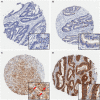Maspin as a Prognostic Marker for Early Stage Colorectal Cancer With Microsatellite Instability
- PMID: 32587829
- PMCID: PMC7297950
- DOI: 10.3389/fonc.2020.00945
Maspin as a Prognostic Marker for Early Stage Colorectal Cancer With Microsatellite Instability
Abstract
Colorectal cancers are among the most common cancers and a leading cause of cancer death. In our pursuit to discover molecular markers for better characterization and precision theranostics of these cancers, we first conducted global deep proteome analyses and identified maspin (serpin B5, peptidase inhibitor 5) as an upregulated protein in tumor tissue. We then validated its expression in a large cohort of 743 patients with colorectal cancers of all stages and found that both cytoplasmic and nuclear expression varied widely between different patients. Comparison with clinicopathological features revealed that maspin expression levels correlate significantly only with mismatch repair (MMR) status but not with other features. To elucidate the prognostic significance of maspin, we analyzed two outcome-annotated cohorts, one of 572 early stage cancer patients and another of 93 late stage cancer patients. Kaplan-Meier survival, univariate, and multivariate analyses revealed that maspin overexpression predicts longer overall and disease-free survival for early stage microsatellite instability (MSI) subtype colorectal cancer, but there is no correlation with survival for patients with early stage cancer of the microsatellite stability (MSS) subtype or late stage cancer. Our study identifies maspin expression as an independent prognostic marker for risk stratification of early stage MSI subtype colorectal cancer and may provide guidance for improved therapeutic management.
Keywords: biomarker; colorectal cancer; maspin; pathology; prognosis; serpin B5.
Copyright © 2020 Tanaka, Wang, Shia, Zhou, Ogawa, Hendrickson, Klimstra and Roehrl.
Figures






Similar articles
-
DEAD-box RNA helicase protein DDX21 as a prognosis marker for early stage colorectal cancer with microsatellite instability.Sci Rep. 2020 Dec 16;10(1):22085. doi: 10.1038/s41598-020-79049-9. Sci Rep. 2020. PMID: 33328538 Free PMC article.
-
Elevated nuclear maspin expression is associated with microsatellite instability and high tumour grade in colorectal cancer.J Pathol. 2005 Apr;205(5):606-14. doi: 10.1002/path.1732. J Pathol. 2005. PMID: 15714592
-
Nuclear maspin expression correlates with the CpG island methylator phenotype and tumor aggressiveness in colorectal cancer.Int J Clin Exp Pathol. 2015 Feb 1;8(2):1920-8. eCollection 2015. Int J Clin Exp Pathol. 2015. PMID: 25973084 Free PMC article.
-
Implications of mismatch repair-deficient status on management of early stage colorectal cancer.J Gastrointest Oncol. 2015 Dec;6(6):676-84. doi: 10.3978/j.issn.2078-6891.2015.065. J Gastrointest Oncol. 2015. PMID: 26697201 Free PMC article. Review.
-
Is There a Role for Programmed Death Ligand-1 Testing and Immunotherapy in Colorectal Cancer With Microsatellite Instability? Part I-Colorectal Cancer: Microsatellite Instability, Testing, and Clinical Implications.Arch Pathol Lab Med. 2018 Jan;142(1):17-25. doi: 10.5858/arpa.2017-0040-RA. Epub 2017 Nov 16. Arch Pathol Lab Med. 2018. PMID: 29144791 Review.
Cited by
-
Proteomic basis for pancreatic acinar cell carcinoma and pancreatoblastoma as similar yet distinct entities.NPJ Precis Oncol. 2024 Oct 3;8(1):221. doi: 10.1038/s41698-024-00708-5. NPJ Precis Oncol. 2024. PMID: 39363045 Free PMC article.
-
Correlation between Maspin Levels in Different Biological Samples and Pathologic Features in Colorectal Adenocarcinomas.Life (Basel). 2023 Apr 20;13(4):1060. doi: 10.3390/life13041060. Life (Basel). 2023. PMID: 37109589 Free PMC article.
-
Transcriptome Profiling of A549 Xenografts of Nonsmall-cell Lung Cancer Treated with Qing-Re-Huo-Xue Formula.Evid Based Complement Alternat Med. 2022 Sep 16;2022:2882801. doi: 10.1155/2022/2882801. eCollection 2022. Evid Based Complement Alternat Med. 2022. PMID: 36159573 Free PMC article.
-
P176S Mutation Rewires Electrostatic Interactions That Alter Maspin Functionality.ACS Omega. 2023 Jul 26;8(31):28258-28267. doi: 10.1021/acsomega.3c01850. eCollection 2023 Aug 8. ACS Omega. 2023. PMID: 37576651 Free PMC article.
-
Proteome-based pathology: the next frontier in precision medicine.Expert Rev Precis Med Drug Dev. 2021;6(1):1-4. doi: 10.1080/23808993.2021.1854611. Expert Rev Precis Med Drug Dev. 2021. PMID: 33768159 Free PMC article. No abstract available.
References
-
- Figueredo A, Charette ML, Maroun J, Brouwers MC, Zuraw L. Adjuvant therapy for stage II colon cancer: a systematic review from the Cancer Care Ontario Program in evidence-based care's gastrointestinal cancer disease site group. J Clin Oncol. (2004) 22:3395–407. 10.1200/JCO.2004.03.087 - DOI - PubMed
Grants and funding
LinkOut - more resources
Full Text Sources
Molecular Biology Databases

